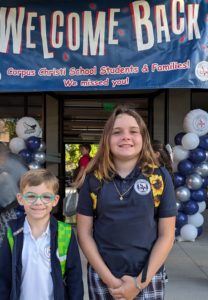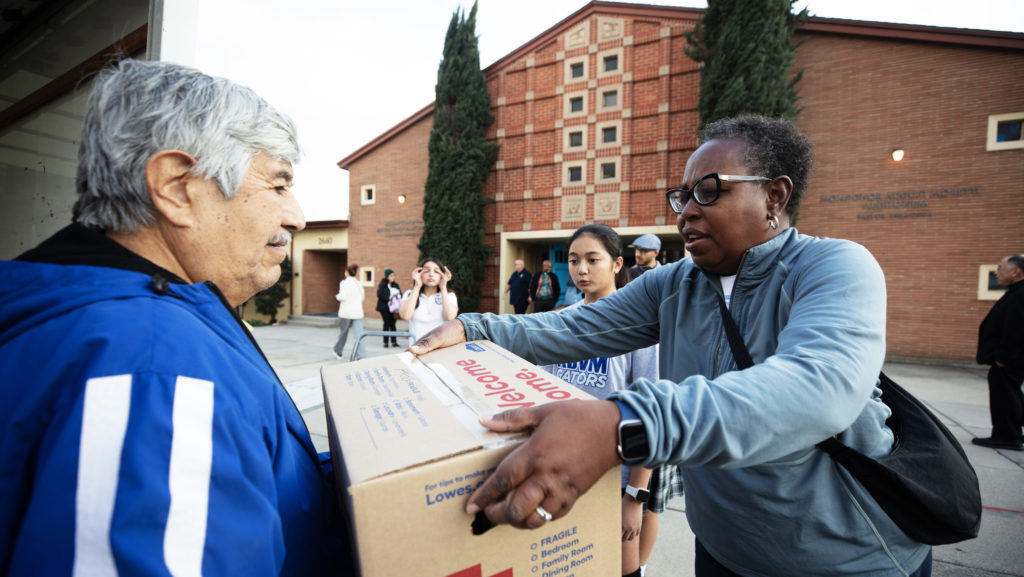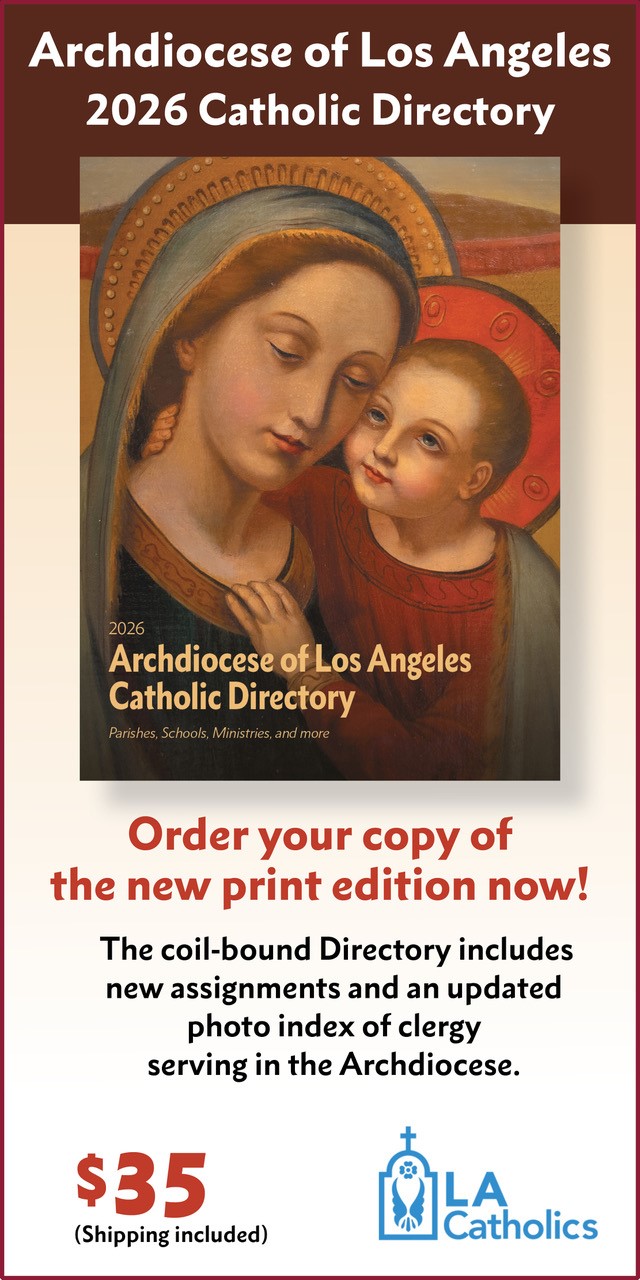Not many have experienced the uneasiness the LA fires caused as uniquely as Phyllis Cremer, the principal at St. Elizabeth School in Altadena. Not only did students and parents turn to her as the Eaton Fire ravaged their homes, but she herself was evacuated, and is now displaced, because of fire damage to her home.
“It’s like a death,” she said. “Here’s this life that I had that is no longer and that literally went away. Now, being an administrator for a school that is dispersed is probably the hardest thing that I have ever experienced.”
But if anyone can help navigate and make sense of what happened, where the school community goes from here, and how not to lose faith in the process, it’s Cremer.
“It sounds corny, but I was made for this,” said Cremer, whose husband, Doug, is a deacon at St. Elizabeth Church. “I want to take care of people … I am fighting for my family and fighting for all families, and fighting for my faith.”
For Catholic school families in areas hit hardest by the fires — particularly at St. Elizabeth School and Corpus Christi School in Pacific Palisades — that hope is needed as they work out where, why, and how to send their children to school.
The Department of Catholic Schools has said that 915 students in 76 of the Archdiocese of Los Angeles’ schools were displaced by the fires, as well as several teachers, staff, and administrators, too.
While many students have since returned to their normal schools, others have been temporarily taken in by other campuses, such as American Martyrs School in Manhattan Beach, St. Martin of Tours School in Brentwood, and Assumption of the Blessed Virgin Mary School in Pasadena.
Some have moved out of the area. Others went out of state. Another left the country altogether.
While grateful for being able to still send their children to Catholic school, some families said the uncertainty caused by the fires has taken a toll on them.
Courtney Graff, whose children Sydney and Robert attended Corpus Christi School, said it’s been hard not to be able to provide them with “concrete answers” about the future.
“We said the house is gone, the church is gone. Part of the school appears to be there, but the school is not open right now. We don’t know when it will be,” she said.
***
Like many families when they first heard about the distant Palisades Fire, Elizabeth Beall and her husband both never thought it would reach their home on the south side of the community.

“In order for the fire to reach us, it would have to burn the whole Palisades,” Beall recalled thinking. “Earlier that day, that seemed impossible. We were like, there’s no way it’s going to burn the whole village.”
Beall’s children Teresa and Charlie were at Corpus Christi School the morning the Palisades Fire started. By noon, the school had emailed parents asking them to pick up their students.
The Bealls decided to evacuate for at least the night, still expecting to return. They even left a car in the driveway.
On the news that night, they watched their neighbor’s house become engulfed in flames. It started to sink in that they weren’t going to have a house to return to.
Graff and her family were equally shocked to learn that their house — which they shared with her parents, including her blind father and mother, both in their 80s — was no longer there.
“Then you find out the church is gone, the school is gone, the entire town is gone,” Graff said. “And this is a school that I went to. This is a church that I went to, a church that my sisters and I got married in.”
“The school felt like home to me because I’ve been going there for so long, and the teachers and the principal, I’ve known them forever,” said Graff’s daughter, Sydney, a fifth-grader at Corpus Christi.
***
It didn’t take long for Anna-Marie Silva, the Department of Catholic Schools’ superintendent for the San Gabriel Pastoral Region, to realize the fires were going to be “something that we hadn’t encountered before.”
Having handled previous emergencies before, the DCS team kicked into gear and began working with schools, asking: Is everyone safe? Are any structures threatened? What’s the air quality like? Which schools need to close?
When the magnitude hit of how many families were being affected, the focus shifted to finding out where students were, how to help them get necessities, and how to keep them connected as a community of faith.
“Our role is always accompaniment,” Silva said. “That’s how we define what we do. We accompany wherever we’re at.”
It soon became clear — especially in Corpus Christi and St. Elizabeth’s case — that students would need to be steered to other schools.
DCS began calling principals in the surrounding areas, asking them to take in displaced students. Figuring out the logistics of tuition, uniforms, and laptops would come later.

“The principals were great,” Silva said. “They’re welcoming the families. They’re including the kids and things, but also being very sensitive that they’re still mourning.”
Beall said Corpus Christi families began breaking off into groups, with a large contingent getting rental homes in the South Bay and taking their students to American Martyrs. But Beall and her husband wanted their children to be with as many of their close classmates as possible, so eventually decided to follow another group to St. Martin of Tours in Brentwood.
“We felt like for our kids, the most important thing was going to be to keep them with their friends and to keep that continuity,” Beall said.
Both the Bealls and the Graff families said they and their children are handling the situation as best they can. While there are some minor inconveniences, such as meeting new teachers, learning a new math program, a longer commute — the Bealls used to walk to school — they’re also taking any success they can. Charlie Beall has bonded with the St. Martin basketball team. Sydney Graff is enjoying the STEAM lab.
“Even though it’s hard sometimes, and to think about that my whole home is gone now, it’s just that was how God wanted it to be,” Teresa Beall said.
***
Both Corpus Christi and St. Elizabeth principals acknowledge that their job is “a lot harder” now than before.
“Transferring mail over there, going to pick up the mail, making sure that the families are OK,” said Corpus Christi principal Paola Sessarego. “And emailing constantly, to keep them updated. It's a lot of little pieces here and there.”
Both principals shared a moment recently where they silently acknowledged the pain — for themselves, for their schools, for their families.
“We didn’t say anything, but we hugged each other and cried,” Cremer said. “To have someone, without saying words, to understand where you’re at. Just to know that I have someone on this earth hurting just as much as I am.”
Looking ahead, the extensive cleaning and rebuilding of Corpus Christi and St. Elizabeth make it difficult to project when each will reopen.
But both the Graffs and the Bealls are ready for when that happens.
“No, we will, we’ll be back,” Elizabeth Beall said.
The Wildfire Catholic School Tuition Relief Fund has been created to pay for students who have been displaced by the wildfires to continue attending Catholic school. To donate, visit cefwildfiretuitionrelief.funraise.org.
Editor-in-Chief Pablo Kay also contributed to this story.

